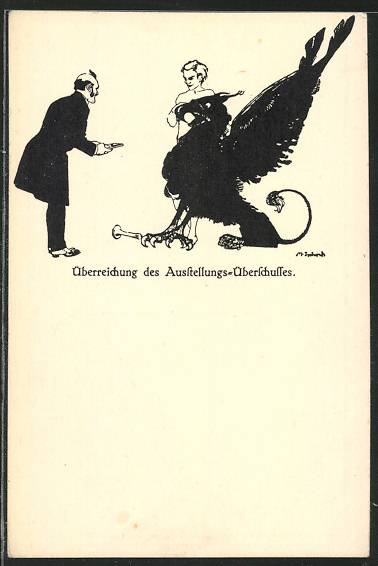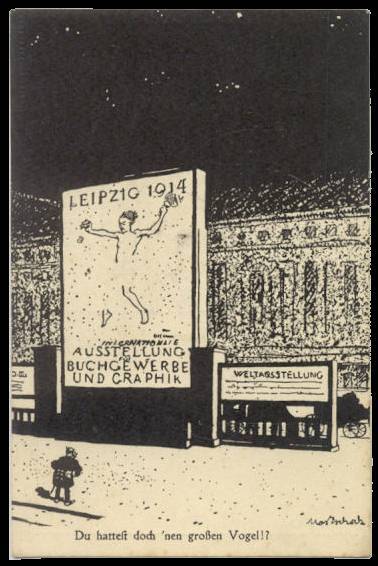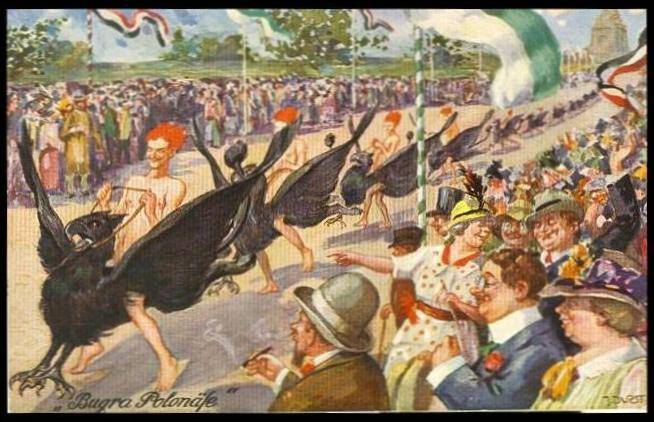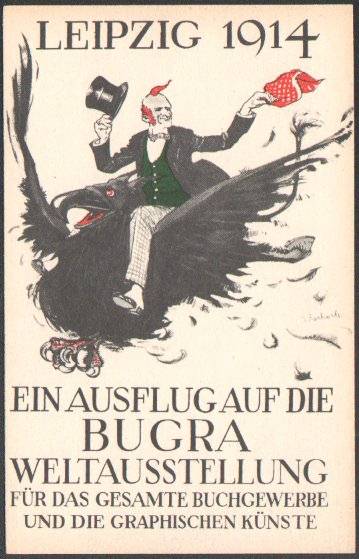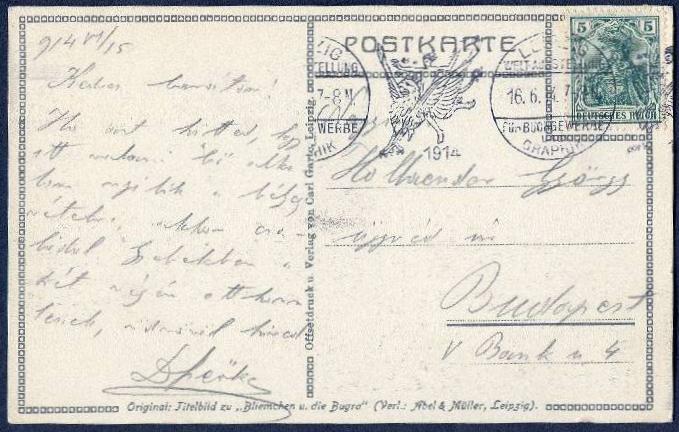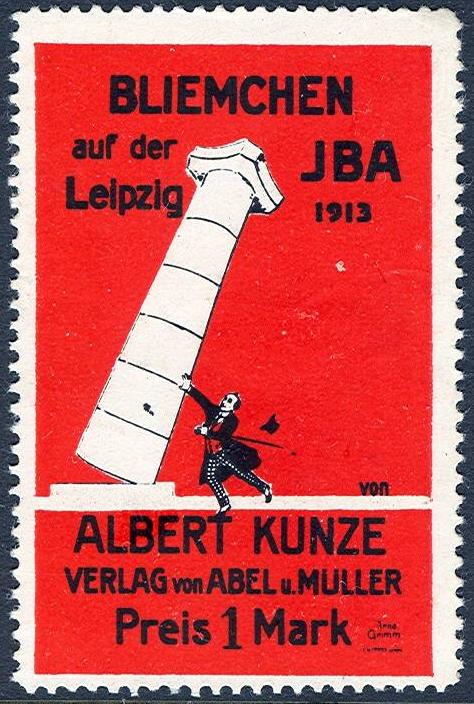POSTER STAMPS AND POSTCARDS OF THE BUGRA -- LEIPZIG, 1914
Internationale Ausstellung für Buchgewerbe und Graphik
|
Introduction The Königliche Akademie für Graphische Künste und Buchgewerbe New York Times article about the Bugra
|
PARODIES AND IMITATIONS OF THE BUGRA POSTER I have encountered three parodies or imitations of the Walter Tiemann design for the Bugra poster. One (the first below) may have been created by Tiemann himself. The others were almost certainly created by others, and reflect a reaction of surprise to Tiemann's design, which, let's face it, must have seemed pretty wild in 1914. |
|
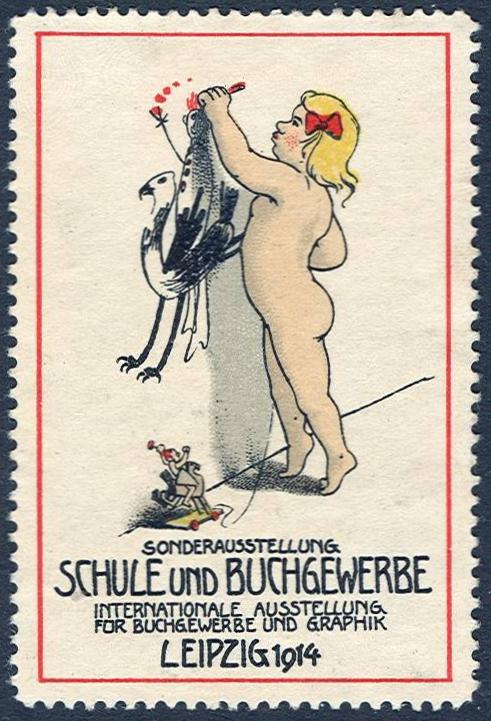
|
"Start 'em Young!"
This is one of three stamps issued for the special section "Das Kind Und Die Schule" (The Child And The School). I think this one is Tiemann's own work, since it was issued for one of the official sections of the show. A naked child is drawing on the wall, and at her feet is a pull toy. Both the drawing on the wall and the pull toy are parodies of the "Prometheus on a gryphon" image. Cute. It looks like Tiemann had a sense of humor.
|
|

|
"Who the bleep tore my umbrella!?"
Actually, a literal translation of the text (Hol doch gleich der teufel das malefiz, regendach das ganz lumpige zerrissene!) on this very large stamp (it's a full 2-1/4" wide by 3-1/8" tall, compared to a more ordinary 1-1/2" x 2-1/4" for the "real" stamp) would be "To the devil with the villain who tore my umbrella!" The designer or printer's name - "E. NISTER" and "NÜRNBERG" are in the lower right corner, but otherwise there's nothing to explain who produced it, or why. To me it is simply someone's way of poking fun at Tiemann's poster design. Good-naturedly, I would say. At first glance, one would think it is simply an oversize version of the actual design, it so closely parodies the image, but once one reads the text and looks closer, all the details jump out. The gryphon is not a gryphon at all, but an umbrella, and its elements have been cleverly altered to fit the new concept. It's still a mystery what he's throwing from his right hand. I'd sure like to know the details of its production, and Tiemann's reaction. 7/12/10 - I did a little research on the www and learned HERE that "In the late nineteenth century Ernest Nister was one of the best known and most innovative makers of movable and popup books for children with their colourful chromolithographs. He began his company in Nuremburg, Bavaria, then a centre of German toy making. Later he opened a London branch, where translations were prepared for the English market. Eventually he expanded the business to America, where Duttons in New York became his publisher." That's interesting, but it doesn't asnwer my questions about this stamp. 1/19/2018 - I just found the postcard at left, which I almost overlooked, assuming it was one of the official products with the official image. But its image is the same as that on the stamp above it, and it was produced by the same "E. NISTER" of "NÜRNBERG" - a great find! |
|
|
Miscellaneous Postcards
I have found three of these so far. The first shows the Gryphon and rider on the ground, and I have to say, the rider's expression is hostile! At left is a well-dressed gentleman holding out a small plate. On the ground at the Gryphon's feet is the extinguished torch the rider was carrying. The caption translates "Handing over the Exhibition profits." On the back it says "At the Bugra 1914." The second shows a man at the gates of the exhibition looking up at a huge reproduction of the poster with rider, but no gryphon. A loose translation of the caption would be "But where's your big bird?" The third shows a parade of gryphons and riders, with the caption "Bugra Polonaise." |
||

|
Bliemchen And The Bugra
This last parody cannot be mistaken for the original design, though its similarity is unmistakable. It exists as both a poster stamp and two postcards. The basic image on all three is the same, but the text differs. The image shows a balding, middle-aged man with plaid pants, green vest, and a black frock coat, a black top hat in one hand, and a red handkerchief in the other. He is riding a cartoonish version of the gryphon, which is plump and disheveled, feathers flying. On the stamp, the text is an advertisement for a book about the exhibition - it says "Bliemchen and the Bugra by Albert Kunze" then names the publisher and price - 1 Mark. One postcard tells us on its address side that the image on the other side is the title page of the book, with the text "Best Wishes from a flight to the Bugra!" The other says just "A Trip to the Bugra, etc." So this parody is clearly more of an homage to the original, as well as an ad for the book. HERE is actual cover of the booklet. 07/12/2010 - a friend just wrote to say that she thinks this image represents the boy and gryphon forty years later - all grown up and much the worse for wear. I love it. I haven't been able to find out anything about Albert Kunze, but assume from the image that he was a humorist and/or travel writer. I have a stamp from the 1913 Leipzig International Baufach Ausstellung advertising a similar book "Bliemchen auf der I.B.A." by the same author, with Bliemchen propping up a falling column. Some research about Bliemchen led me to some further guesses about the book. First, "bliemchen" is Leipzig dialect for bluemchen, or little flower. There is a golden rose local to the area called the Leipziger Bliemchen. Second, there was a humorist (Edwin Bormann) who lived and worked in Leipzig, who wrote satirical stories and articles in the local dialect under the pseudonym Bliemchen. He died in 1912. Third, I have seen humorous postcards of that period showing a cartoonlike bumpkin named Fritze Bliemchan, perhaps based on the character Bormann created in his writing, or simply on local stereotypes. Also, the writer Gustav Schumann wrote humorous travel stories under the name Bliemchen in the 1890's. So my theory is that this book was written by someone in the style Bormann and/or Schumann had established, and using his pseudonym. The diagram certainly suggests a comic figure. |
|


|
||
All text and images are the property of the author. Any errors are his.
If you have better or additional information about anything shown or discussed here, please Email the webmaster.
Home

Send feedback to the webmaster: CLICK HERE
Created -- 07/11/2010
Revised -- 08/15/2025

